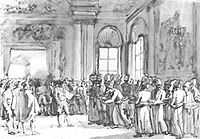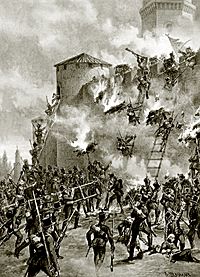Russo-Persian War (1804–1813) facts for kids
Quick facts for kids Russo-Persian War (1804–1813) |
|||||||||
|---|---|---|---|---|---|---|---|---|---|
| Part of the Russo-Persian Wars, Russian conquest of the Caucasus and the Napoleonic Wars | |||||||||
 This painting by Franz Roubaud illustrates an episode near the Askerna river where the Russians managed to repel attacks by a larger Persian army for two weeks. They made a "living bridge", so that two cannons could be transported over their bodies. |
|||||||||
|
|||||||||
| Belligerents | |||||||||
| Commanders and leaders | |||||||||
| Strength | |||||||||
| 48,000 troops, 21,000 irregular cavalry | 50,000 Nezam-e Jadid (modern style infantry), 20,000 irregular cavalry, 25,000 other allied or old style Persian troops | ||||||||
The Russo-Persian War of 1804–1813 was a major conflict between the Persian Empire and Imperial Russia. It started because both empires wanted to control the same land, especially in what is now Georgia. The new Persian king, Fath Ali Shah Qajar, wanted to secure his northern borders. At the same time, the Russian Tsar, Alexander I, also wanted to control these areas.
The war ended in 1813 with the Treaty of Gulistan. This treaty gave Russia control over Georgia and other Persian lands. These lands included parts of Dagestan, most of modern-day Azerbaijan, and some parts of Armenia.
Contents
Why the War Started
The main reason for this war was Russia's decision to take over Georgia in 1800. Years earlier, Georgia had asked Christian Russia for protection. After Tsar Paul I died, his son, Tsar Alexander I, continued this plan. He wanted Russia to control the areas in the eastern Caucasus region.
In 1803, the Russian commander, Paul Tsitsianov, attacked the Persian town of Ganja. On January 15, 1804, the Russians captured Ganja. Its governor, Javad Khan Qajar, was killed, and many people in the town were killed too. The Persian ruler, Fath Ali Shah, saw this as a direct threat to his power and lands like Armenia and Azerbaijan.
Armies and Technology
Russia was fighting many other wars at the same time. These included wars against France, the Ottoman Empire, Sweden, and Great Britain. Because of this, Russia could not send many soldiers to the Caucasus.
The Russians had to rely on better technology, training, and battle plans. They were often outnumbered by the Persian army, sometimes by as much as five to one. The Persian heir, Abbas Mirza, tried to make his army more modern. He sought help from French and then British experts to improve his soldiers' skills and equipment.
First Battles of the War
The war began when Russian commanders Ivan Gudovich and Paul Tsitsianov attacked Echmiadzin. This was a very holy town in Armenia. Gudovich failed to capture Echmiadzin and then also failed to capture Yerevan.
Even with these early struggles, Russia generally had the upper hand. This was due to their better-trained soldiers and strategies. However, Russia could only send about 10,000 troops to the region. This allowed the Persians to put up a strong fight. Most of the Persian troops were irregular cavalry, meaning they were not as well-trained as regular soldiers.
Holy War and Persian Defeat
In 1810, the Persians increased their efforts by declaring a jihad, or holy war, against Russia. But Russia's better technology and tactics led to many victories. Even though Persia was allied with Napoleon, who was fighting Russia, France could not offer much direct help.
Even when French forces occupied Moscow, Russia did not pull its troops from the south. Instead, they continued fighting Persia. Russian General Pyotr Kotlyarevsky won important battles at Aslanduz in 1812 and Lenkoran in 1813. After these defeats, Persia surrendered. The Treaty of Gulistan gave Russia control over most of the disputed lands. This also meant that the local rulers, called khans, had to accept Russian rule.
Key Events of the War
The war involved many battles and changes in control over different areas.
- 1804: After taking Ganja, Russian forces tried to capture Echmiadzin and Yerevan but failed.
- 1805: Russia gained control of the Karabakh Khanate and Shaki Khanate. Persian forces under Abbas Mirza tried to stop them but were defeated in several clashes.
- 1806: The Russian commander Tsitsianov was killed while accepting the surrender of Baku. Russia then took control of other Caspian Sea cities like Derbent and Quba. The Russo-Turkish War also began, dividing Russia's attention.
- 1808-1810: Fighting continued with mixed results. Russia took Echmiadzin again. A Russian attack on Yerevan failed, with many soldiers dying from cold during the retreat. Abbas Mirza tried to invade Karabakh but was defeated.
- 1812: Persia invaded Karabakh and won a rare victory against a Russian battalion. However, Russia soon sent General Pyotr Kotlyarevsky to the front. He led a surprise attack at Aslanduz, defeating the Persian army.
- 1813: Kotlyarevsky then stormed the fortress of Lankaran after a long siege. This was a very bloody battle, with heavy losses on both sides. News of Napoleon's defeat in Russia reached Persia, weakening their position.
Diplomacy and Alliances

This war was also affected by what was happening in Europe during the time of Napoleon. Persia, needing allies and money, asked Britain for help. However, Britain was allied with Russia against France, so they could not help Persia at first.
This opened the door for France. Napoleon wanted to use Persia to threaten both Russia and Britain. In 1807, France and Persia signed the Treaty of Finckenstein. In this treaty, France recognized Persia's claims to Georgia and promised to help train the Persian army.
However, just two months later, Napoleon made peace with Russia. This made France's promises to Persia difficult to keep. The French still offered some military help, but their efforts to make peace between Russia and Persia failed.

Britain became worried about France's influence in Persia, seeing it as a threat to India. When France and Russia became allies, Britain had a chance to reconnect with Persia. Britain then promised to train Persian soldiers and provide money if Persia was invaded. This encouraged Persia to continue the war.
But then, in 1812, Napoleon invaded Russia. This made Russia and Britain allies again. Britain found itself in a difficult spot, having promised to help Persia against its new ally, Russia. Britain decided to help settle the conflict between Russia and Persia.
The British ambassador, Gore Ouseley, realized that Persia's situation would worsen once Russia was no longer fighting Napoleon. He pressured Persia to accept a peace deal. He also reduced British military help and threatened to stop payments.
In 1812, peace talks began. After the major Russian victories at Aslanduz and Lankaran, and with Napoleon's defeat, Russia pushed for a stronger position. Persia, despite wanting to fight on, eventually had to agree to a treaty.
The Treaty of Gulistan (1813)
The war ended with the Treaty of Gulistan in October 1813. This treaty officially recognized Russia's control over the South Caucasus region. Russia gained control of western and eastern Georgia. It also took control of several Muslim areas, called khanates, up to Baku and Quba.
Aftermath of the War
The Treaty of Gulistan made Russia the main power in the Caucasus region. However, Russia still faced threats from the Ottoman Empire. Thirteen years later, from 1826 to 1828, Persia tried to regain its lost territories in another war. But Persia was defeated again and lost even more land, including the areas that are now modern Armenia.
Historians note that Russia's well-trained and equipped army was much stronger than Persia's forces. For example, at the Battle of Aslanduz, 2,260 Russian soldiers fought 30,000 Persians. The Russians killed many Persian soldiers while losing far fewer of their own. Even in battles where Persians fought bravely, like at Lankaran, the war was clearly lost for Persia.
See also
- Russo-Persian War (1826-1828)
- Khanates of the Caucasus


